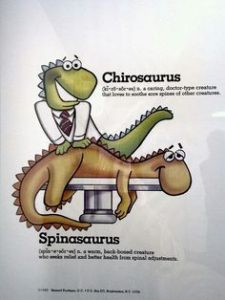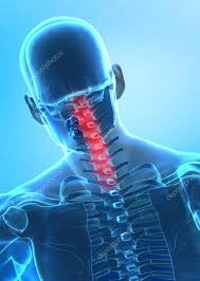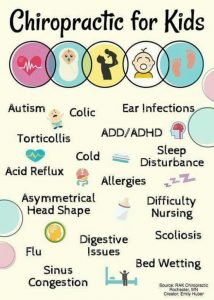Here’s a Little Humor to Finish the Week!

We hope you have a wonderful weekend! Stay warm and safe!

We hope you have a wonderful weekend! Stay warm and safe!
 A very recent review of prophylaxis of migraine was published in the Canadian Medical Journal (1). To say the least, their findings were remarkable. Although this was a medically oriented review, several herbal and nutritional approaches were rated as effective as drug therapy with significantly fewer reported adverse events. Table 1 is a summary of the findings of the review for interventions when the outcome measure used was the odds ratio of a 50% decrease in frequency of migraine. All findings were based on studies that were graded by the authors as A or B evidence based on the United States Preventive Services Task Force criteria.
A very recent review of prophylaxis of migraine was published in the Canadian Medical Journal (1). To say the least, their findings were remarkable. Although this was a medically oriented review, several herbal and nutritional approaches were rated as effective as drug therapy with significantly fewer reported adverse events. Table 1 is a summary of the findings of the review for interventions when the outcome measure used was the odds ratio of a 50% decrease in frequency of migraine. All findings were based on studies that were graded by the authors as A or B evidence based on the United States Preventive Services Task Force criteria.
Table 1
| Intervention | Quality of evidence | Odds ratio of 50% decrease in frequency |
Adverse effects |
| Divalproex | A | 2.74 | Frequent at higher dosages |
| Gabapentin | B | 4.51 | Occasional |
| Topirmate | A | 2.44 | Frequent |
| Amitriptyline | B | 2.41 | Occasional |
| Propranolol | B | 1.94 | Infrequent |
| Riboflavin (400 mg/day) | A | 5.60 | Infrequent |
| Butterbur (50 mg B.I.D) | A | 2.24 | Infrequent |
Pharmaceutical interventions are obviously favored by the medical community even when, at least according to this review, riboflavin and butterbur demonstrate equal or superior effectiveness in A graded studies yet report infrequent adverse effects.
Butterbur: A 2006 systematic review reported on 2 randomized trials (RCT) of butterbur extract (Petasities hybridus) which totaled 293 patients. In these studies a 150 mg dose of butterbur was more effective than a 100 mg dose over a period of 3 to 4 months. Overall butterbur demonstrated a decreased frequency of migraine in over 50% of patients. The brand name of the form of butterbur used in this study was Petadolex (2). In an open label study of 109 children and adolescents the authors found 77% of all patients reported at least a 63% reduction in the frequency of migraine (3). Although no significant adverse effects have been reported in the studies mentioned above, concerns relating to hepatotoxicity have been reported in the literature. A recent study utilizing Petadolex found it to be “free of signals for drug induced liver injury” (3). Several authors have suggested butterbur may be a valuable tool in the prevention of migraine (4-7).
Feverfew: Feverfew is herb that has demonstrated effectiveness in the prevention of migraine in some studies and conflicting results in other studies. Three Cochrane reviews have been published relating to feverfew. The original review could not demonstrate efficacy for feverfew (8) but an update published the same year reported “feverfew is likely to be effective in the prevention of migraine (9). The third review returned to the original position stating “there is insufficient evidence” to suggest an effect (10). A separate article suggested the reason for lack of efficacy reported in the most recent Cochrane review was the 400% variation in the active ingredient in the studies evaluated (5). One RCT published after the Cochrane reviews showed migraine attacks decreased from 4.76 attacks per month to 1.9 when using MIG-99 after 3 months. A dosage of 6.25 mg t.i.d. were used (11). All studies reported a favorable safety profile.
Coenzyme Q10: Coenzyme Q10 has demonstrated efficacy in 1 RCT and several open trial design studies. The RCT was a study of 42 patients. The dosage was 100 mg t.i.d. There was a 50% decrease in headache frequency in 42.6% of the patients in the active treatment group compared to 14.4% in the placebo group after 3 months. The number needed to treat was 3 (12). Another case series found similar benefits using 150mg daily (13). None of the studies on coenzyme Q10 reported adverse effects.
Riboflavin: A RCT compared a combination of riboflavin (400 mg), magnesium (300 mg) and feverfew (100 mg) to 25 mg of riboflavin. Both groups achieved statistically significant improvements over baseline. The authors noted both groups exceeded the normal placebo response reported in other migraine prevention studies. This study suggests a small dose of riboflavin may be an effective prophylaxis for migraine (14). Another RCT using 400 mg daily reported statistically significant improvements in headache frequency and headache days after 3 months. The number needed to treat in this study was 2.3 (15). Unfortunately 2 studies of riboflavin in children did not demonstrate improvement (16;17).
Magnesium: A 2008 RCT examined the prophylactic effect of 600 mg of magnesium citrate daily for 3 months compared to a placebo. Statistically significant improvements in frequency and severity were found in the treatment group. Additionally cortical blood flow increased significantly in the treatment group (18). A second RCT also found a statistically significant decrease in migraine frequency after 3 months using 360/mg per day (19). Not all RCTs have shown magnesium to be of effective. A 1996 RCT found no benefit when using magnesium (20). Soft stools and diarrhea were a common mild adverse event occurring in 18.6% (19) to 47.7% (20) in the magnesium groups.
Several other interventions have limited evidence demonstrating effectiveness. They include ginkgolide B (21), lipoic acid ( 600 mg/day) (22) and fish oil or olive oil (23).
It should be noted that time frame of treatment almost all prevention studies is 3 months. Treatment success or failure should not be assessed prior to completion of 3 months of the intervention.
Article is shared from www.chiroaccess.com
[amd-zlrecipe-recipe:3]
Today’s Rice Pudding Recipe was shared from the following website: https://sweetleaf.com/stevia-recipes/sugar-free-cinnamon-vanilla-rice-pudding/

A healthy spine is an often overlooked and essential part of a healthy lifestyle. People who suffer from back pain, particularly if it is long-term, are generally less healthy than those who do not. In fact, back pain costs are staggering not only financially, but also in terms of lost time from work and because of psychosocial problems that arise during the healing process associated with long-term back pain.
Unfortunately, approximately 80-90% of the population suffers from spinal pain at some point. People who are overweight or obese, and who smoke, lift heavy objects, or had a previous episode of back pain, are more likely to experience back pain.
Because so many people suffer from spine pain, it’s important for you to try to keep your spine as healthy as possible. Following simple posture, lifting, and healthy lifestyle guidelines can help you keep your back in good shape. One of the best things you can do for your spine is to get regularly adjusted. If you are in need of an adjustment, be sure to call our office at 406-652-3553 and schedule an appointment with Dr. Oblander. In the meantime, here are some good ways to take care of your spine:
The American Chiropractic Association recommends the following spinal health tips:
Standing
• When standing, keep one foot slightly in front of the other, with your knees slightly bent. This position helps to take the pressure off your low back.
• Do not stand bent forward at the waist for prolonged periods of time. The muscles in your low back become deconditioned in this position, which may lead to pain.
Lifting
• At all times, avoid twisting while lifting. Twisting is one of the most dangerous movements for your —spine, especially while lifting.
• If the item is too heavy to lift, pushing it is easier on your back than pulling it. Whenever possible, use your legs, not your back or upper body, to push the item.
• If you must lift a heavy item, get someone to help you.
Sitting
• Keep your knees slightly higher than your hips, with your head up and back straight.
• Avoid rolling your shoulders forward (slouching).
• Try to maintain the natural curve in your low back.
Reaching and Bending
• When reaching for something above shoulder level, stand on a stool. Straining to reach such objects may
not only hurt your mid-back and neck, but it can also bring on shoulder problems.
• Do NOT bend over at the waist to pick up items from the floor or a table.
• Instead, kneel down on one knee, as close as possible to the item you are lifting, with the other foot flat on the floor and pick the item up.
• Or bend at the knees, keep the item close to your body, and lift with your legs, not your back.
Carrying
• When carrying objects, particularly if they are heavy, keep them as close to your body as possible.
• Carrying two small objects—one in each hand—is often easier to handle than one large one.
Healthy Diet and Exercise
• While the proverbial jury is still out, we suspect that extra weight puts undue strain on your spine. Keep within 10 lbs. of your ideal weight for a healthier back.
• “Beer belly” is likely the worst culprit, as it puts unwanted pressure on the muscles, ligaments and ten- dons in your low back.
• The most efficient and effective way to reduce weight is by eating a sensible diet and exercising regularly.
• Consult with your doctor before beginning any exercise program, particularly if you have a health condition.
Sleeping
• Sleeping on your back puts approximately 50 pounds of pressure on your spine. Other positions may be better
.
• Placing a pillow under your knees while lying on your
back cuts the pressure on your spine roughly in half.
• Lying on your side with a pillow between your ——– knees may also reduce the pressure on your back.
• Never sleep in a position that causes a portion of —- your spine to hurt. Most often, your body will tell you what position is best.
Quit Smoking
Smokers have more spine pain than nonsmokers, and they also heal more slowly when they have an episode of back pain because the chemicals in tobacco smoke restrict the flow of blood to the tissues in and around your spine.
While following these instructions is no guarantee that you’ll be free from back pain for your entire life, it can certainly reduce your risk of developing it. These simple steps will help you keep your spine in good shape, making you a healthier, happier person.
Lawrence H. Wyatt, DC, DACBR, FICC, Professor, Division Of Clinical Sciences, Texas Chiropractic College, Writer
Nataliya Schetchikova, PHD, Editor
This health article was shared from the following website: http://www.chiroworkscarecenter.com/documents/Articles/ACA_healthy_spine.pdf
[amd-zlrecipe-recipe:2]

Today we are sharing an article from Forbes magazine on how losing weight can save you money. Just ask our doc – Dr. Greg Oblander, losing weight saves you more than just money. Think that you are doomed to all of the health woes and diseases that have plagued your parents and grandparents? Would it surprise you to know that genetics only affect about 5% of health issues? Yup, it’s true. Our health is mainly determined by our health and lifestyle choices. Love that Big Mac? Well…it doesn’t love you! Today’s article cites a report that estimates that losing weight will save the average person at least $10,000 over a lifetime. We think that estimate is way low. (Think cost of cancer treatment, heart surgery, escalating medical costs). Money issues aside, how much is it worth to you to not have chronic pain, joint issues, arthritis, heart disease, diabetes, cancer…and the list goes on? Deciding now to get rid of extra weight and adopt the habit of exercise and eating real food will save you both health woes and money! An added bonus is that you will learn a greater degree of self-discipline! If you would like to change your lifestyle habits and/or lose weight, we can help! Call our Oblander Chiropractic office at 406-652-3553 and schedule your free consultation!
Please enjoy today’s article from Forbes magazine:
Losing weight can save you money over your lifetime.
Want another reason to lose weight? How about making your wallet heavier? In our study just published in the journal Obesity, we showed how much money that losing weight can save at any age, whether you are Millennial at 20 years old or a member of the Greatest Generation at 80 years old.
Five members of our Global Obesity Prevention Center (GOPC) at Johns Hopkins University (Saeideh Fallah-Fini, Atif Adam, Lawrence J. Cheskin, Sarah M. Bartsch and I) developed a computational model that simulated an adult at different starting ages and weights and calculated what could happen to the person’s weight, health and associated costs over time for the rest of his or her life. (Dr. Fallah-Fini is also an Assistant Professor of Engineering at the California State Polytechnic University.) Think of this model as a virtual person whom we can follow like a friend while the person ages.
For example, a simulated person could start as overweight at age 20 and then with each passing simulated year of the person’s life gain or lose weight and develop different types of chronic weight-related conditions such as diabetes, heart disease and cancer, just like a real person. The simulation would continue until the person died from either age-related causes or a weight-related condition such as having a fatal heart attack.
At the end of the simulation, we could then tabulate the amount of medical costs that occurred (e.g., hospitalizations and medications for stroke) and the amount of productivity losses that resulted (e.g., lost salary from being disabled or missing days of work for hospitalizations, clinic visits, falling ill or passing away early). By running the model with different starting weights (e.g., within the ideal body weight range) and then comparing the results, we could then see how medical costs and productivity losses may change with losing or gaining weight.
The model utilized data from a variety of sources such as the Coronary Artery Disease Risk Development in Young Adults (CARDIA) and Atherosclerosis Risk in Communities (ARIC) studies, the Framingham Heart Study (FRS), the Northern Manhattan Stroke cohort study, the National Cancer Institute database, the National Health Interview Survey, the Medical Expenditure Panel Survey (MEPS) and the Bureau of Labor Statistics. Dr. Adam played a major role in assembling and analyzing all of this data to help construct the model.
On average, going from obesity to normal weight, a 20-year-old could save a net present value of more than $28,000 throughout their lifetime, a 40-year-old more than $30,000, a 50-year-old more than $36,000, a 60-year-old more than $34,000, a 70-year-old more than $29,000 and an 80-year-old more than $16,000.
Going from overweight to an ideal weight range could save more than $10,000 at any age from 20 to 80, peaking at age 60 ($18,604). It may be that “love don’t cost a thing,” but obesity or being overweight certainly do.
In nearly all situations, at least half of these costs are from productivity losses (lost salary). In many cases, productivity losses constituted as high as nearly two-thirds of the costs. Since we used median wages, if you make much more, then losing weight could save you substantially more than the numbers we reported.
These numbers actually may be underestimates because the model focused on just a handful of major weight-related health conditions. We didn’t account for costs associated with a number of other weight-related issues such as joint problems and mental health issues such as anxiety and depression.
Extra weight not only hits you in the gut, but potentially in the heart, the brain, the liver, the kidneys and other parts of the body, and also the wallet.
And since we are all connected with each other via taxes (assuming that you pay taxes), insurance premiums (assuming that you pay for insurance) and the economy (assuming that you are a person and not a wombat), extra weight for someone else also may end up hitting your wallet, too.
Today’s article is shared from the following website: https://www.forbes.com/sites/brucelee/2017/09/27/how-much-money-you-can-save-from-losing-weight-at-different-ages/#7a2e40295c2a
 Statistics compiled by the American Chiropractic Association (ACA) tell us that back pain affects a large majority of the population, with roughly 80 percent of people enduring at least one back-related issue during the course of their lives. In fact, there are currently 31 million people in the U.S. alone dealing with chronic, daily back pain.
Statistics compiled by the American Chiropractic Association (ACA) tell us that back pain affects a large majority of the population, with roughly 80 percent of people enduring at least one back-related issue during the course of their lives. In fact, there are currently 31 million people in the U.S. alone dealing with chronic, daily back pain.
With these types of numbers floating around, chiropractic patients may feel as if their back pain is inevitable, making the seeking of treatment futile. However, one recently released study review says otherwise, that is, as long as the treatment plan includes chiropractic.
The Journal of the American Medical Association (JAMA) published a systematic review and meta-analysis conducted by 10 medical professionals from medical centers, universities, and healthcare systems across the U.S. The main question this group set out to answer was, “Is the use of spinal manipulative therapy in the management of acute (≤6 weeks) low back pain associated with improvements in pain or function?”
After taking a more in-depth look at 26 different randomized clinical trials occurring between January of 2011 and February of 2017, all of which involved spinal manipulative therapy (SMT), this set of researchers found that, in 15 of the studies, this particular treatment option provided “statistically significant benefits” for the 1,711 patient subjects when it came to lowering their levels of pain. In this same group of studies, almost half of the cases (12) also found major positive effects in regard to the level of function of the 1,381 participants when compared to sham chiropractic or other treatment methods.
It should also be noted that, while 50 to 67 percent of the participants in these studies reported experiencing headaches, muscle stiffness, or even increased pain after SMT, no serious adverse events occurred. This helps confirm chiropractic’s safety, making it a viable method of treating acute back pain episodes quickly and effectively.
These findings are extremely important as another statistic offered by the ACA is that approximately 50 percent of the working population has struggled with some type of back-pain issue in the previous 12 months. Thus, one very effective way to keep them earning an income and supporting their families in a manner that treats the symptoms and cause of their pain is regular and consistent chiropractic care.
This saves them both time off work and money due to unnecessary (and usually costly) medical bills, enabling them to spend both on the things they enjoy instead.

Sugar is in almost everything we eat. In the typical western diet, enough sugar has been added to food products to bring our consumption of the sweet stuff up to 22.7 teaspoons per day. It is added to processed foods to extend shelf life and enhance flavor and texture. While we know that sugar contributes to weight gain, diabetes and heart disease, it’s still hard to resist. Why? Much of the answer to that question has to do with the way humans have evolved to survive in times of scarcity.
Our ancestors who had developed a taste for sugar were able to add to their body fat, which helped to keep them alive during periods of famine. This in turn allowed them to pass their sweet-loving genes on to their progeny. A study conducted by researchers at Washington University found that we are programmed from birth to crave sweet things. Human breast milk is very sweet due to the concentration of the sugar lactose, so from day one we learn to develop a sweet tooth.
One study showed how even the mere expectation of sugar can affect our cognitive ability. Scientists found that when study subjects swished sugar water around in their mouths and then spit it out, they performed better on cognitive tests than the subjects who had swished water that had been artificially sweetened. And there is a good reason why sugar is addictive. Eating sugar prompts the release of the hormone serotonin from the same area of the brain that responds to heroin and cocaine, inducing a feeling of happiness and euphoria.
It’s not always obvious where sugar is hiding in the foods we eat. While our consumption of table sugar is down, the amount added to processed foods is increasing. Many people are surprised to find how much sugar is added to such things as bologna (1.18 tsp. per 4 slices), ketchup (1.77 tsp. per 3 tbsp.) and low-fat fruit yogurt (6.16 tsp.). A couple of spoons of barbecue sauce have about as much sugar as a glazed donut! Add in the sugars typically contained in soups, sauces and breads, and it’s easy to see why obesity is becoming such an epidemic. The more we get, the more we want. A sudden rush of sugar spurs the release of insulin, which causes the infamous “sugar crash” and makes us crave even more to combat it.
However, it is possible to overcome an addiction to sugar, just as it’s possible to overcome an addiction to any other substance. Gradually use less where you can, such as in coffee or tea and in your breakfast cereal. You can also reduce or eliminate your consumption of soda (including artificially sweetened soda, which still makes you crave the sweet taste) and water down any fruit juices you may drink. After a while, your body does adjust to the taste. After a few months, if you suddenly are given coffee with sugar in it, you may find it tastes odd. Try to avoid buying store-bought desserts, and if you make your own, reduce the amount of sugar called for in the recipe. Many baked goods can use unsweetened applesauce as a substitute for 2/3 of the sugar required.
Our society has made it difficult to resist sugar, but it’s not impossible, and the less sugar you eat, the better it will be for your overall health.
At Oblander Chiropractic, we are working hard to help our patients live lives of health and wellness. As a part of that effort, we are going to be sharing recipes that replace refined sugar with natural sugars. Be sure to watch our posts for those recipes!
 Many people are under the mistaken impression that the head-sized extension at the top of your car’s seat is a head rest. It’s actually not a place to rest your weary head during a long drive, but rather a safety feature called a head restraint that is there to help prevent whiplash in the event of a rear-end collision. And having it adjusted properly can mean the difference between emerging unscathed and enduring weeks of neck pain, along with the cost and inconvenience of medical treatment.
Many people are under the mistaken impression that the head-sized extension at the top of your car’s seat is a head rest. It’s actually not a place to rest your weary head during a long drive, but rather a safety feature called a head restraint that is there to help prevent whiplash in the event of a rear-end collision. And having it adjusted properly can mean the difference between emerging unscathed and enduring weeks of neck pain, along with the cost and inconvenience of medical treatment.
Whiplash is the most common type of injury in an auto accident. The Insurance Bureau of Canada has conducted studies showing that the proper use of head restraints can reduce the incidence of whiplash by as much as 40%. Russ Rader of the U.S. Insurance Institute for Highway Safety (IIHS) explains what happens when you are involved in a rear end collision: “The head restraint is designed to work with your vehicle’s seat; it keeps your body and head moving together. The problem comes in if your head lags behind your body and snaps backward. That’s what leads to neck injury, or what’s commonly known as whiplash. Modern head restraints are designed to prevent whiplash, and that’s why they’re so much taller than they used to be.”
One problem is that some people find the newest head restraint designs to be uncomfortable. Some of the common complaints from users at Automedia.com include this one from the owner of a Volkswagen Jetta: “The front headrest points so forward that I get neck pain after just a few miles of driving.” Then there’s this one from a Subaru owner: “Unless you enjoy your face aiming toward your crotch, you may not be able to find a comfortable position for the headrest or your head.”
One of the reasons for the above complaints is that, in order to get good reviews from the IIHS (many people check the IIHS’s ratings for vehicles before they purchase a car) and comply with the regulations established by the Federal Government for head restraints, auto manufacturers must provide head restraints that meet specific criteria. In particular, the head restraint must be no more than 2.2 inches from the driver’s head and it must be two or more inches higher than was previously required.
A head restraint can prevent whiplash only if it is as close to your head as possible when a collision happens. When hit from behind, your head snaps quickly backward, then forward, which causes the muscles and tendons in the neck to overstretch and tear. If the head can’t snap back very far, there is much less chance of an injury occurring.
Most head restraints adjust upward and downward, and some also tilt forward and back. The best position for a head restraint is one in which the head is as close to it as possible, ensuring it is no more than two inches away. The top of the head restraint should ideally be even with the top of your head and should never be any lower than your ears.
Taking just a little time and effort to position your head restraint correctly can save you a lot of pain and suffering if you are ever in an auto accident. Your health and safety are worth it!

We have patients surprised all the time when we share all of the things
that chiropractic can do for kids! How many chiropractic helps did you
already know about? We hope you learned something new today!